| a. | Though George kept on reading the story still bothered him | 1545 |
| b. | Though George kept on reading the story Sue bothered him | 1160 |
The pair in 1 becomes disambiguated once you get to still in a. or Sue in b. The parsing strategy that would apply to this pair is Late Closure, which would claim that in the first clause the noun phrase (the story) that follows the verb (reading) is the object of that verb. When the sentence continues with Sue bothered him (as in b.) this is fine, but when it continues with still bothered him (as in a.) the reader will experience a 'garden path' and have to do some extra work (possibly with some re-reading) in order to properly analyse the sentence as one in which reading does not have an explicit object, and where the story is the subject of the next clause (the story still bothered him). The longer reading time for the a. sentence matches this prediction from Late Closure.
The sentences would be disambiguated by punctuation, i.e. by a comma after reading in a., or after story in b. Partial syntactic trees are given below.
| Early Closure version in a. | Late Closure version in b. |
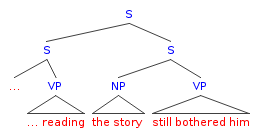 |
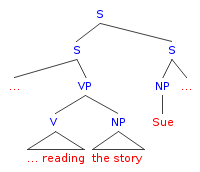 |
| a. | The teacher told the children the ghost story that she knew would frighten them | 1359 |
| b. | The teacher told the children the ghost story had frightened that it wasn’t true | 3150 |
The pair in 2 becomes disambiguated once you get to that in a. or had in b. The parsing strategy that would apply to this pair is Minimal Attachment. In both a. and b. the phrase the ghost story is part of the direct object of the verb told (the phrase the children is the indirect object in both cases), but Minimal Attachment attaches this phrase in the simplest way to the Verb Phrase, i.e. as a noun phrase object. This is fine in a. (where the sentence is then completed by attaching that she know would frighten them as a clause modifying ghost story), but not in b., where the the ghost story is in fact the subject of a clause that modifies children. This could be made explicit by putting who(m) before the ghost story in b. Partial syntactic trees are given below.
| partial tree for a. | partial tree for b. |
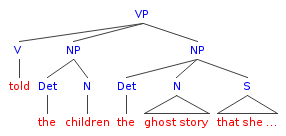 |
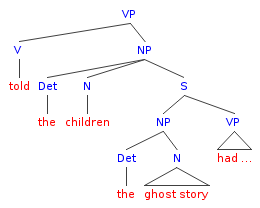 |
| a. | Without her contributions the funds are inadequate | 973 |
| b. | Without her contributions would be very inadequate | 1985 |
The pair in 3 is another example involving the Late Closure strategy. The pair becomes disambiguated once you get to the funds in a. or would be in b. The Late Closure preference is to include contributions as part of the noun phrase that is within the prepositional phrase that starts with without. This is fine in a., but not in b. Note also that the syntactic structure involves a different interpretation of the category ambiguous word her, which is a determiner (possessive) in a., but a pronoun in b.
The analysis could be made explicit by using a comma after contributions in a. or after her in b. Partial syntactic trees are given below.
| Late Closure in a. | Early Closure in b. |
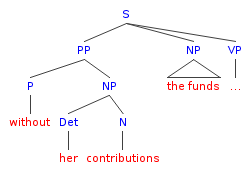 |
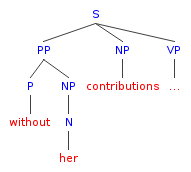 |
| a. | Sally was relieved when she found out the answer to the physics problem | 1224 |
| b. | Sally found out the answer to the physics problem was in the book | 1647 |
The sentences in 4 are clearly not as similar to one another as the other pairs we have looked at. Importantly, note that although 4b is shorter, participants took longer to make the grammaticality judgement about it. The structural ambiguity concerns the object of found out. In a. it is the noun phrase the answer to the physics problem, while in b. it is the clause the answer to the physics problem was in the book. Under Minimal Attachment, the noun phrase object in a. is preferred as the clausal object in b. requires an additional S node between the NP the answer to the physics problem and the VP.
The analysis in b. could be made explicit by using a complementiser that after found out in order to introduce the clausal object. Partial syntactic trees are given below.
| Minimal Attachment in a. | Non-minimal Attachment in b. |
 |
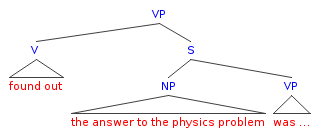 |